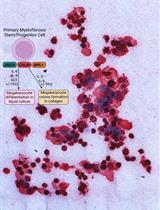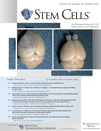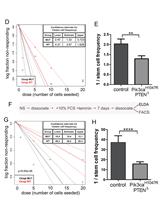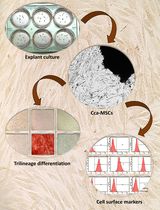- EN - English
- CN - 中文
Melanoma Stem Cell Sphere Formation Assay
黑色素瘤干细胞球体形成测定
发布: 2017年04月20日第7卷第8期 DOI: 10.21769/BioProtoc.2233 浏览次数: 14972
评审: Anonymous reviewer(s)

相关实验方案

来自骨髓增生性肿瘤患者的造血祖细胞的血小板生成素不依赖性巨核细胞分化
Chloe A. L. Thompson-Peach [...] Daniel Thomas
2023年01月20日 2172 阅读
Abstract
Self-renewal is the ability of cells to replicate themselves at every cell cycle. Throughout self-renewal in normal tissue homeostasis, stem cell number is maintained constant throughout life. Cancer stem cells (CSCs) share this ability with normal tissue stem cells and the sphere formation assay (SFA) is the gold standard assay to assess stem cells (or cancer stem cells) self-renewal potential in vitro. When single cells are plated at low density in stem cell culture medium, only the cells endowed with self-renewal are able to grow in tridimensional clusters usually named spheres. In the recent years, SFA has also been used also to test the effect of several drugs, chemical and natural compounds or microenviromental components on stem cells self-renewal capacity. Here we will illustrate a detailed protocol to assess self-renewal of human melanoma stem cells, growing as melanospheres.
Keywords: Melanoma (黑色素瘤)Background
Cancer stem cells (CSCs) were first found in acute myeloma leukemia (Lapidot et al., 1994) and then were identified in many solid tumors including melanoma. CSCs are defined as cells strongly endowed with self-renewal and tumor initiating capacity, being able to regenerate the whole tumor heterogeneity in vivo. CSCs can be isolated from the tumor mass with different approaches based on phenotypic characteristic or biological properties, then their properties have to be tested in vitro (self-renewal) and in vivo (tumorigenic potential). Melanoma CSCs were isolated using a combination of cell surface markers, (Fang et al., 2005; Monzani et al., 2007; Schatton et al., 2008; Boiko et al., 2010; Boonyaratanakornkit et al., 2010) or through culture in specific stem cell media (Perego et al., 2010; Santini et al., 2012). To validate melanoma CSC self-renewal, and to study the effect of tumor microenvironmental factors on it (Tuccitto et al., 2016), we used the sphere formation assay (SFA) in vitro. Melanoma CSCs are plated at low density in stem cell culture medium and they grow in anchorage-independent, three-dimensional spherical structures, called melanospheres (tumorspheres, in general). Spheres forming efficiency is directly proportional to the number of melanoma CSCs present in the culture (one CSC corresponds to one melanosphere), thus giving a direct quantification of CSC amount in culture. This relatively simple method is useful to study the ability of any exogenous factors (growth factors, cytokines and chemokines, drugs) in perturbing CSC self-renewal (Tsuyada et al., 2012; Tuccitto et al., 2016). Here we provide detailed information about the SFA protocol we optimized in our laboratory for melanoma SFA.
Materials and Reagents
- Cell culture flask, area 150 cm2 (Corning, catalog number: 430823 )
- 15 ml Falcon tube (Greiner Bio One International, catalog number: 188261 )
- Micropipette P200 tips (Corning, catalog number: 4823 )
- 24-wells plates flat bottom (Corning, Costar®, catalog number: 3527 )
- 70 μm cell strainer (Corning, Falcon®, catalog number: 352350 )
- 15 ml polystyrene serological pipets (Corning, Falcon®, catalog number: 357551 )
- Melanospheres are obtained as described by Perego et al., starting from cell suspension obtained from melanoma surgical specimens or from previously established melanoma cell lines after culturing in stem cell medium (SCM) (Perego et al., 2010)
- RPMI
- 10% FBS
- Trypan blue solution, 0.4% (Sigma-Aldrich, catalog number: T8154 )
- SCM (see Recipes)
- DMEM:F-12, 1:1 mixture’ (Lonza, catalog number: BE12-719F )
- Epidermal growth factor (EGF) (PeproTech, catalog number: AF-100-15 )
- Basic fibroblast growth factor (bFGF) (PeproTech, catalog number: 100-18B )
- D-glucose (Sigma-Aldrich, catalog number: G7021 )
- Insulin (Sigma-Aldrich, catalog number: I6634 )
- Putrescine dihydrochloride (Sigma-Aldrich, catalog number: P5780 )
- Sodium selenite (Sigma-Aldrich, catalog number: S9133 )
- Progesterone (Sigma-Aldrich, catalog number: P6149 )
- Transferrin (Sigma-Aldrich, catalog number: T8158 )
- Sodium bicarbonate (NaHCO3) (Sigma-Aldrich, catalog number: S8761 )
- 1x phosphate buffered saline (PBS) (Lonza, catalog number: 17-516 )
- Bovine serum albumin (BSA) (Sigma-Aldrich, catalog number: A1933 )
- HEPES buffer (Lonza, catalog number: BE17-737 )
- L-glutamine (Lonza, catalog number: BE17-605E )
- Penicillin-streptomycin (Lonza, catalog number: 17-602E )
Equipment
- Automatic pipettor (PBI, catalog number: 857075 )
- Tissue culture incubator with CO2 input (Thermo Fisher Scientific, Thermo ScientificTM, model: FormaTM Series II 3110 )
- Centrifuge (Eppendorf, catalog number: 5810 )
- Hemocytometer (Marienfeld-Superior, Bürker, catalog number: 0640211 )
- Optical microscope (Carl Zeiss, model: Axiovert 25 )
Procedure
文章信息
版权信息
© 2017 The Authors; exclusive licensee Bio-protocol LLC.
如何引用
Tuccitto, A., Beretta, V., Rini, F., Castelli, C. and Perego, M. (2017). Melanoma Stem Cell Sphere Formation Assay. Bio-protocol 7(8): e2233. DOI: 10.21769/BioProtoc.2233.
分类
癌症生物学 > 癌症干细胞 > 细胞生物学试验 > 自我更新
干细胞 > 成体干细胞 > 癌症干细胞
细胞生物学 > 基于细胞的分析方法 > 非贴壁培养
您对这篇实验方法有问题吗?
在此处发布您的问题,我们将邀请本文作者来回答。同时,我们会将您的问题发布到Bio-protocol Exchange,以便寻求社区成员的帮助。
提问指南
+ 问题描述
写下详细的问题描述,包括所有有助于他人回答您问题的信息(例如实验过程、条件和相关图像等)。
Share
Bluesky
X
Copy link











